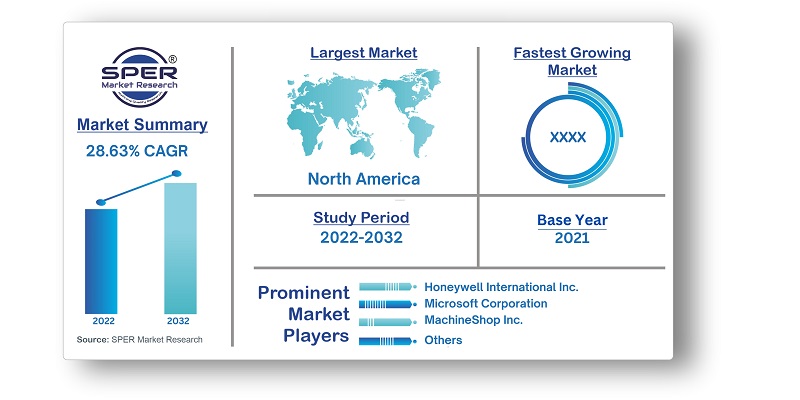
Connected Enterprise Market Share, Demand, Growth, Challenges And Future Outlook 2022-2032
Connected Enterprise Market Size- By Platform, By Solution, By Service, By End User- Regional Outlook, Competitive Strategies and Segment Forecast to 2032
| Published: Jan-2023 | Report ID: IACT2306 | Pages: 1 - 235 | Formats*: |
| Category : Information & Communications Technology | |||


| Report Metric | Details |
| Market size available for years | 2019-2032 |
| Base year considered | 2021 |
| Forecast period | 2022-2032 |
| Segments covered | By Platform, By Solution, By Service, By End User |
| Regions covered | Asia Pacific, Europe, Middle East and Africa, North America, Latin America |
| Companies Covered | Accelerite, Cisco Systems Inc., General Electric Company, Harman International, Honeywell International Inc., IBM Corporation, Jacobs Engineering Group Inc., MachineShop Inc., Microsoft Corporation, PTC Inc., Rockwell Automation Inc., Verizon Communications Inc., Wipro Limited |
- Application Developers and Aggregators
- Data Management and Predictive Analysis Companies
- Embedded Systems Companies
- Internet Identity Management, Privacy, and Security Companies
- Machine-to-Machine (M2M), and Telecommunications Companies
- Managed Service Providers and Middleware Companies
- Semiconductor Companies
- Sensor, Location and Detection Solution Providers
- Wireless Infrastructure Providers and Service Providers
- Application Enablement
- Connectivity Management
- Device Management
- Asset Performance Management
- Customer Experience Management
- Data Management
- Enterprise Infrastructure Management
- Consulting Services
- Integration and Deployment Services
- Managed Services Consulting Services
- Integration and Deployment Services
- Managed Services
- BFSI
- Energy and Utilities
- Government
- Healthcare and Life Sciences
- Manufacturing
- Asia-Pacific
- Europe
- Middle East & Africa
- North America
- Latin America
- Size of Global Connected Enterprise Market (FY’2019-FY’2032)
- Overview of Global Connected Enterprise Market
- Segmentation of Global Connected Enterprise Market By Platform (Application Enablement, Connectivity Management, Device Management)
- Segmentation of Global Connected Enterprise Market By Solution (Asset Performance Management, Customer Experience Management, Data Management, Enterprise Infrastructure Management, Mobile Workforce Management, Network Management, Real-Time Collaboration, Remote Monitoring System, Security Solution, Streaming Analytics)
- Segmentation of Global Connected Enterprise Market By Service (Consulting Services, Integration and Deployment Services, Managed Services, Professional Services, Support and Maintenance)
- Segmentation of Global Connected Enterprise Market By End User (BFSI, Energy and Utilities, Government, Healthcare and Life Sciences, Manufacturing, Media and Enterprises, Retail and Ecommerce, Telecommunication and IT, Others)
- Statistical Snap of Global Connected Enterprise Market
- Growth Analysis of Global Connected Enterprise Market
- Problems and Challenges in Global Connected Enterprise Market
- Competitive Landscape in the Global Connected Enterprise Market
- Impact of COVID-19 and Demonetization on Global Connected Enterprise Market
- Details on Recent Investment in Global Connected Enterprise Market
- Competitive Analysis of Global Connected Enterprise Market
- Major Players in the Global Connected Enterprise Market
- SWOT Analysis of Global Connected Enterprise Market
- Global Connected Enterprise Market Future Outlook and Projections (FY’2019-FY’2032)
- Recommendations from Analyst
1.1. Scope of the report1.2. Market segment analysis
2.1 Research data source
2.1.1 Secondary data2.1.2 Primary data2.1.3 SPER’s internal database2.1.4 Premium insight from KOL’s
2.2 Market size estimation
2.2.1 Top-down and Bottom-up approach
2.3 Data triangulation
4.1. Driver, Restraint, Opportunity and Challenges analysis
4.1.1 Drivers4.1.2 Restraints4.1.3 Opportunities4.1.4 Challenges
4.2. COVID-19 Impacts of the Global Connected Enterprise Market
5.1. SWOT analysis
5.1.1 Strengths5.1.2 Weaknesses5.1.3 Opportunities5.1.4 Threats
5.2. PESTEL analysis
5.2.1 Political landscape5.2.2 Economic landscape5.2.3 Social landscape5.2.4 Technological landscape5.2.5 Environmental landscape5.2.6 Legal landscape
5.3. PORTER’S five forces analysis
5.3.1 Bargaining power of suppliers5.3.2 Bargaining power of Buyers5.3.3 Threat of Substitute5.3.4 Threat of new entrant5.3.5 Competitive rivalry
5.4. Heat map analysis
6.1 Global Connected Enterprise Manufacturing Base Distribution, Sales Area, Product Type6.2 Mergers & Acquisitions, Partnerships, Product Launch, and Collaboration in Global Connected Enterprise Market
7.1 Application Enablement7.2 Connectivity Management7.3 Device Management
8.1 Asset Performance Management8.2 Customer Experience Management8.3 Data Management8.4 Enterprise Infrastructure Management8.5 Mobile Workforce Management8.6 Network Management8.7 Real-Time Collaboration8.8 Remote Monitoring System8.9 Security Solution8.10 Streaming Analytics
9.1 Consulting Services
9.2 Integration and Deployment Services
9.3 Managed Services
9.4 Professional Services9.5 Support and Maintenance
10.1 BFSI10.2 Energy and Utilities10.3 Government10.4 Healthcare and Life Sciences10.5 Manufacturing10.6 Media and Enterprises10.7 Retail and Ecommerce10.8 Telecommunication and IT10.9 Others
11.1 Global Connected Enterprise Size and Market Share by Region (2019-2025)11.2 Global Connected Enterprise Size and Market Share by Region (2026-2032)11.3 Asia-Pacific
11.3.1 Australia11.3.2 China11.3.3 India11.3.4 Japan11.3.5 South Korea11.3.6 Rest of Asia-Pacific
11.4 Europe
11.4.1 France11.4.2 Germany11.4.3 Italy11.4.4 Spain11.4.5 United Kingdom11.4.6 Rest of Europe
11.5 Middle East & Africa
11.5.1 Kingdom of Saudi Arabia11.5.2 United Arab Emirates11.5.3 Rest of Middle East & Africa
11.6 North America
11.6.1 Canada11.6.2 Mexico11.6.3 United States
11.7 Latin America
11.7.1 Argentina11.7.2 Brazil11.7.3 Rest of Latin America
12.1 Accelerite
12.1.1 Company details12.1.2 Financial outlook12.1.3 Product summary12.1.4 Recent developments
12.2 Cisco Systems Inc.
12.2.1 Company details12.2.2 Financial outlook12.2.3 Product summary12.2.4 Recent developments
12.3 General Electric Company
12.3.1 Company details12.3.2 Financial outlook12.3.3 Product summary12.3.4 Recent developments
12.4 Harman International
12.4.1 Company details12.4.2 Financial outlook12.4.3 Product summary12.4.4 Recent developments
12.5 Honeywell International Inc.
12.5.1 Company details12.5.2 Financial outlook12.5.3 Product summary12.5.4 Recent developments
12.6 IBM Corporation
12.6.1 Company details12.6.2 Financial outlook12.6.3 Product summary12.6.4 Recent developments
12.7 Jacobs Engineering Group Inc.
12.7.1 Company details12.7.2 Financial outlook12.7.3 Product summary12.7.4 Recent developments
12.8 MachineShop Inc.
12.8.1 Company details12.8.2 Financial outlook12.8.3 Product summary12.8.4 Recent developments
12.9 Microsoft Corporation
12.9.1 Company details12.9.2 Financial outlook12.9.3 Product summary12.9.4 Recent developments
12.10 PTC Inc.
12.10.1 Company details12.10.2 Financial outlook12.10.3 Product summary12.10.4 Recent developments
12.11 Rockwell Automation Inc.
12.11.1 Company details12.11.2 Financial outlook12.11.3 Product summary12.11.4 Recent developments
12.12 Verizon Communications Inc.
12.12.1 Company details12.12.2 Financial outlook12.12.3 Product summary12.12.4 Recent developments
12.13 Wipro Limited
12.13.1 Company details12.13.2 Financial outlook12.13.3 Product summary12.13.4 Recent developments
SPER Market Research’s methodology uses great emphasis on primary research to ensure that the market intelligence insights are up to date, reliable and accurate. Primary interviews are done with players involved in each phase of a supply chain to analyze the market forecasting. The secondary research method is used to help you fully understand how the future markets and the spending patterns look likes.
The report is based on in-depth qualitative and quantitative analysis of the Product Market. The quantitative analysis involves the application of various projection and sampling techniques. The qualitative analysis involves primary interviews, surveys, and vendor briefings. The data gathered as a result of these processes are validated through experts opinion. Our research methodology entails an ideal mixture of primary and secondary initiatives.



Frequently Asked Questions About This Report
PLACE AN ORDER
Year End Discount
Sample Report
Pre-Purchase Inquiry
NEED CUSTOMIZATION?
Request CustomizationCALL OR EMAIL US
100% Secure Payment






Related Reports
Our Global Clients
Our data-driven insights have influenced the strategy of 200+ reputed companies across the globe.




















